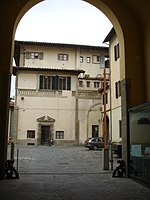San Marco, Florence
1443 establishments in Europe15th-century Roman Catholic church buildings in Italy15th-century establishments in the Republic of FlorenceBasilica churches in FlorenceCommons category link is locally defined ... and 5 more
Convents in ItalyDominican churchesDominican conventsMonasteries in TuscanyRenaissance architecture in Florence

San Marco is a religious complex in Florence, Italy. It comprises a church and a convent. The convent, which is now the Museo Nazionale di San Marco, has three claims to fame. During the 15th century it was home to two famous Dominicans, the painter Fra Angelico and the preacher Girolamo Savonarola. Furthermore, the church houses the tomb of Pico Della Mirandola, Renaissance philosopher and so called father of humanism.
Excerpt from the Wikipedia article San Marco, Florence (License: CC BY-SA 3.0, Authors, Images).San Marco, Florence
Via Camillo Cavour, Florence Quartiere 1
Geographical coordinates (GPS) Address Nearby Places Show on map
Geographical coordinates (GPS)
| Latitude | Longitude |
|---|---|
| N 43.778445 ° | E 11.258545 ° |
Address
Via Camillo Cavour 53
50120 Florence, Quartiere 1
Tuscany, Italy
Open on Google Maps









